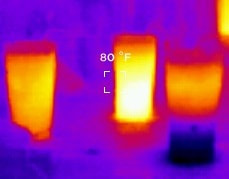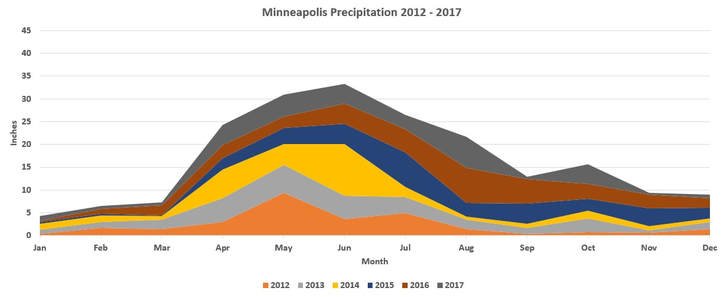Please note, if duplicating this process do NOT use a microwave to extract the moisture from the soil in order to avoid damaging the microwave.
Our world is over 70% open water and conduction is the primary means of heat discharge that our world uses. Water is found under land everywhere around the world at different depths and concentration levels, and how this heat moves under land is researched and recorded.
|
In order to understand heat loss, soil was dried out in an oven over night. Both the soil and water were then matched at 120F and recorded over time. A third sample was then filled with 6oz of the same water and then the heated soil was added. As you can observe in the video to the right, soil was 48.5% the thermal mass of water, exactly what is expected. The soil/water mix accelerated drastically to 97% the thermal mass of water. The bare soil represents an arid environment absent of water. Most land, specifically arable land, is soil/water mix at different variables.
|
|

In this next video the same process for heating the soil was used and then placed over water. The water used was 144F hot tap water, room temperature water at 74F, and then refrigerated water at 44F. Using a 16oz glass 5oz of water was added and then packed with 120F soil, the results were then recorded. At first we all expect the heated water to expand and breach the surface, but the opposite occurs and appears to violate the laws, but it's actually conforming to the laws.
|
This is discharge, meaning the soil is cooling. Beneath the soil air is greatly restricted, even at a very shallow depth, and cooling causes contraction. At the molecular level, as the air between the grains cools a low pressure vacuum is created. The cooler water below is drawn up to the surface offsetting this vacuum and displacing the heat. With the subterranean cooler than the surface, the heat will be naturally drawn to the cooler environment beneath the surface at a more rapid pace creating the results seen in the video. |
|

The 4th glass added at the end of the video was 44F water sealed with the 120F soil. Although the water breached the surface, the concentration levels were not equal to the one with a probe. This indicates that a breach in the surface, like a tree trunk or bush, increases energy flow. If vegetation was added to the experiment, the cooling plant would accelerate water flow and increase energy transfer. The reverse is also true, that decreasing surface vegetation reduces energy flow and will result in warming over time. Warmer than normal nighttime temperatures as experienced in 1995 and 2011 produced a reduction in crop yields even though the fields looked good. Warmer temperatures at night will decrease water flow and results in decreased yields. A plants rooting system is spawn out and is naturally far more efficient for gathering water that is rising rather than absorbing water from the top down through precipitation. Although AgWab indicates this is due to the plant needing "Rest," rest can also be defined as a period of time of increased water flow allowing the plant to cool. AgWeb article can be viewed here.

When summer ends there is a period of time when precipitation tends to increase before winter. This is the heated surface cooling and drawing up the water and is often seen during this period of time as fog. When fall comes and the leaves drop, this process shuts down and conduction over land begins, If the subterranean is warmer than normal, it then releases it at a much slower pace. This warmth creates a delay of entering into winter and increasing fall temperatures into January. This is what has been occurring for many years, but has been accelerating since 2012.